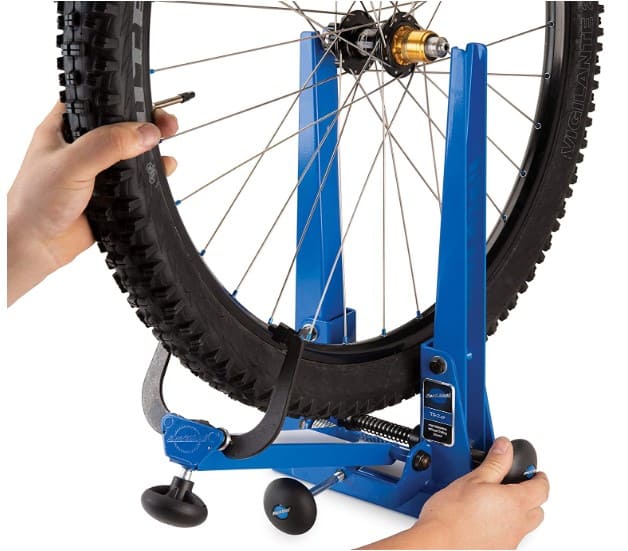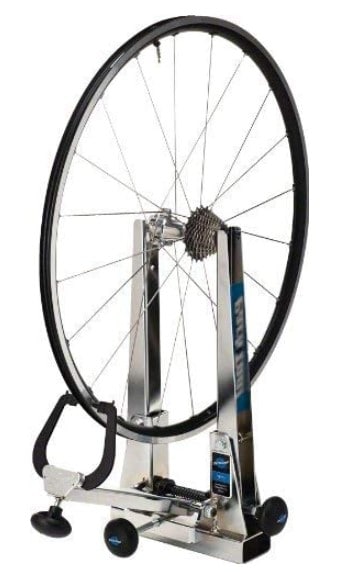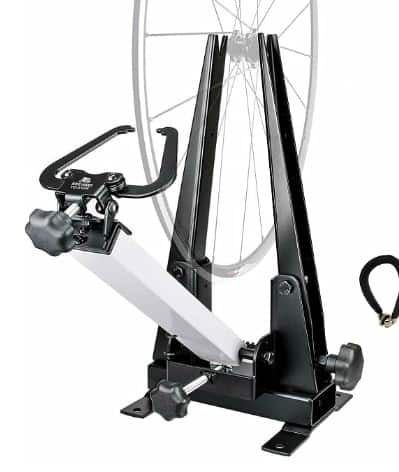It starts with a rattling sound and sometimes a rhythmic rub, and you think it’s the bike’s brake with an issue. Surprise! Surprise! Surprise! It’s got nothing to do with the brake but an untrue wheel. What you should be asking is; how much does it cost to true a bike wheel?
You can expect to spend anything between $10 and $30 to true a bike wheel at the local bike repair shops. But if you decide to go DIY, you’ll spend anything between $80 and $320 on a professional bike truing stand.
The good thing about getting a bike truing stand is that it’s a one-off purchase. So, you may pay more when buying, but that’s about it. You can then true your bike wheel in the future at no cost.
I’ll explain the two cost options in detail. What’s more, we’ll look at the signs of an untrue wheel, the risks of riding on such a bike wheel, and how to fix it.
But first, let’s differentiate a true wheel from an untrue wheel below.

What’s a True Wheel? And What’s An Untrue Wheel?
We use the words true wheel to describe a bike wheel whose rotation enjoys perfect alignment. That means the wheel doesn’t wobble sideways or hop up and down.
The easiest way to check for that is to lift the wheel off the riding surface and give it a quick spin. Then watch the brake pad.
If the wheel wobbles, then it is out of alignment, and we use the name ‘untrue wheel’ to describe it.
Signs Of An Untrue Bike Wheel
You can identify an untrue bike wheel by looking for any of these signs:
- Rattling Sound
If you hear an unusual rattling sound from your bike wheel when cycling, the chances are that the spokes are loose. In that case, the spokes are not offering the wheel any strength, and the situation is no different from that of missing spokes.
The solution is to tighten the bike spokes, and the rattling will stop.
- Vertical Deformation (Flintstones Wheel)
In case the wheel looks deformed vertically (what we call the Flintstones wheel), that is a sign of an untrue wheel. The wheel doesn’t look perfectly round in a Flintstones scenario, and it wobbles when it rolls.
- Rhythmic Rub
In case you hear a rhythmic rubbing-like sound emanating from your bike wheel, it could be nothing to do with the brakes but the wheels.
Though you may try to adjust the brakes, the rubbing may not stop. So, the best fix would be to tighten the loose spokes to align the wheel properly.
- Lateral True
A lateral true is what most people call a rim run-out. It happens when the wheel wobbles sideways.
Usually, the rim produces a dub-dub sound when spinning.
While most people blame the brake in such a scenario, the problem is often in the wheel alignment. As a result, the solution is to true the wheel.
- Floppy Spokes
You can also try moving the spokes by hand. If they wobble, then it means they are loose and thus need tightening. When the wheel is true, the spokes are generally rigid.
What Are The Risk Of Riding On An Untrue Bike Wheel?
While most people consider truing bicycle wheels to improve their cycling experience, that’s not the only reason why you should do it.
In fact, the primary reason for doing that is that of your safety. Riding an untrue bike wheel affects your wheel strength. Simply put, you can easily bend or break the bike rim, and that may lead to a severe accident.
So, to avoid injuring yourself or any other user because of loss of bike control, consider truing your bike wheel when you notice the signs discussed earlier.

What To Do To An Untrue Bike Wheel
The true wheel allows you to cycle more comfortably. So, when your bike wheel is untrue, you’ve to fix it quickly.
It means realigning the wheel and keeping it round, which often calls for the spokes’ tightening. You generally have two options.
First, you can take the bike to the nearest bike repair shop to have the mechanics fix the untrue wheel. Second, you can use a truing stand to fix the bike wheel yourself, as I’ll explain in a few seconds.
How Much Does It Cost To True A Bike Wheel?
Generally, it’ll cost you at least $80 to get a new bike wheel. That’s much more than what you pay at the local shop to get the bike wheel.
And if you do the truing yourself, you’ll need to get a truing stand, which will save you money in the long term. Overall, the cost of truing a bike wheel ranges from $10 to about $320, depending on what option you choose.
a) The Cost To True A Bike Wheel At Local Bike Shops
I don’t expect you to spend more than $30 truing a bike wheel at the local bike repair shop. In most cases, they charge $10-$30 to fix an untrue bike wheel.
The local mechanics have the best equipment for truing bike wheels, and so you only pay a small fee for the service.
b) The Cost To True Bike Wheel With A Professional Bike Truing Stand
Though it’ll cost you more money to get a professional bike stand, it’s the most economical decision you’ll ever make. You’ll only incur the cost once, and you can use a truing stand for a long time.
On average, a truing stand costs $80-$360. I recommend the Park Tool Professional Wheel Truing Stand (View on Amazon) as it’s perfect for all standard bikes. It accepts bicycles with sizes up to 29 inches and a hum width of up to 175mm.

c) Cost Of Strapping The Bike Wheel
This is not exactly trueing bicycle wheels, but it’s a quick fix for an untrue wheel as you think about a better solution.
Generally, this option will cost you around $10, which goes to a bike wheel stabilizer like the Epessa Bike Wheel Stabilizer Straps.
These two-pack wheel stabilizer straps will hold your bike wheel to prevent it from wobbling. The straps are made from easily adjustable, tight-fitting, and slip-resistant nylon for the best performance.
What Tools Would I Need To True My Bike Wheel? ( How Much Does It Cost To True A Bike Wheel?)
Now, if you decide to true your bike wheel, you’ll need these tools:
- Spoke Wrench
A spoke wrench is essential in adjusting the spoke tension and repairing the spoke. It’s vital, however, that you get the right spoke wrench size
If you are looking for a 27-inch, 130-inch, or 136-inch, consider Park Tool SW-7.2 Triple Spoke Wrench.
- Spoke Holder
The spoke holder is only necessary if your wheel features bladed spokes. If not, then the spoke wrench is just enough.
Overall, a spoke holder holds the bike’s spokes firmly to allow you to tighten the loose nipples.
You can check out the Park Tool BSH-4 Spoke Holder that securely holds your bladed spokes for effective wheel truing.
- Truing Stand
The purpose of a truing stand is to hold your bike wheel firmly when realigning it. The stand gives you eye-level comfortable access to the wheel.
You can consider the Bikehand Bicycle Truing Stand (View on Amazon) that I recommended earlier.

- Bike Repair Stand
You can use a bike repair stand like the Bikehand Bike Repair Stand in the absence of a truing stand. It is readily compatible with MTBs and road cycles.
How Do You True A Bike Wheel? Bike Wheel Truing Cost
Now, if you choose to go DIY, here are the steps for truing your bike wheel:
- Before anything, check your wheel for loose spokes and tighten them with a spoke wrench
- Ensure you tighten all loose spokes before turning the bike upside down
- Check for the wheel roundness by removing the bike tire and tube
- Properly examine the rim alignment by placing a straight object such as a ruler close to the rim
- Again, tighten the spokes while spinning the wheel until you are convinced the wheel is round
- Now check for lateral alignment (if the wheel is straight when spinning)
- Remember, an entirely true wheel has all the points from the brake pad in equidistant when you spin
- To check for that, gradually press the brakes as you watch out for the parts that come into contact with the brake first
- Once you notice that, use the wrench to tighten the opposite spokes
- Continue adjusting the spokes until the wheel is perfectly straight
- Lastly, reexamine the adjusted spoke for the last time to confirm that the wheel is aligned correctly
Relevant Posts:
In Conclusion
So, how much does it cost to true a bike wheel? While you’ll pay $10-$30 at the local bike repair shops, you can spend up to $320 on a truing stand.
Generally, if you want to save in the long-term, getting a truing stand is preferable. But if you want a quick fix, you can take the bike wheel for truing at the local mechanic.
Frequently Asked Questions
Is it worth truing a bike wheel?
Absolutely, it’s worth truing a bike wheel. Just think about it from a practical perspective. Your bike wheel is subject to all sorts of impacts and bashes—jumping off a curb onto a hard surface, hitting a hidden pebble, or even the occasional disastrous collision with a pothole. These not-so-gentle bumps can cause your wheel rim to lose its perfect roundness, and a wobbly wheel can seriously ruin your riding experience.
Keeping your wheel true, i.e., perfectly round and straight, is a crucial part of bike maintenance. It ensures that your bike rolls smoothly and efficiently. More importantly, it ensures a safe ride. A misaligned wheel can jeopardize your balance and control over your bike, leading to potentially dangerous situations.
I've seen the issues misalignment can cause first hand. A friend of mine rode through a rugged off-road trail, his wheel smacking against rocks and roots, and he didn't bother to check the wheels. A few rides later, he noticed a strange wobble and took his bike in for a check. Turned out, the wheel had warped without him realizing it. Fortunately, he got it fixed in time, managing to avoid any potential accidents.
So, from my personal experience and the experiences of many other riders, I'd say it's always worth truing a bike wheel, keeping it in shape, and ensuring a safe, smooth ride.
How much does bike wheel truing cost?
How long does truing a wheel take?
Wheel truing is a meticulous process but doesn’t necessarily take an exorbitant amount of time in the hands of a skilled bike mechanic. While the time can vary depending on the extent of the misalignment or damage to the bike wheel, a proficient mechanic typically handles wheel truing within about thirty minutes.
Having personally spent time with a local bike mechanic, I remember being amazed at how professionally and deftly they tightened the spokes, ensuring that the wheel was perfectly true. No wobble, no warping. Just a perfectly straight wheel, rolling smoothly and providing the best riding experience possible. By the time I finished my coffee, they were done with the wheel truing. It was so impressive to witness this process, how intricate it is, and yet how efficiently it gets done.
Is truing a bike wheel difficult?
The perception of difficulty often comes from fear of the unknown, and this holds true for wheel truing too—many people consider it a magical art form, accessible only to the most experienced bike wizards with beards full of wisdom. I’m here to tell you that such imagery, although amusing, is misrepresentation. The reality is that wheel truing is a skill that anyone willing to get their hands dirty can learn.
As long as you have the fundamental understanding of how bike parts function, and you can turn a wrench to tweak things here and there, you're capable of truing your bike wheel. I've seen it with some of my friends who have never trued a wheel before. With a bit of perseverance, patience, and practice, you can become pretty good at this. Trust me, there's a deep sense of satisfaction in riding a bike that rolls smoothly because you've done the wheel truing yourself!